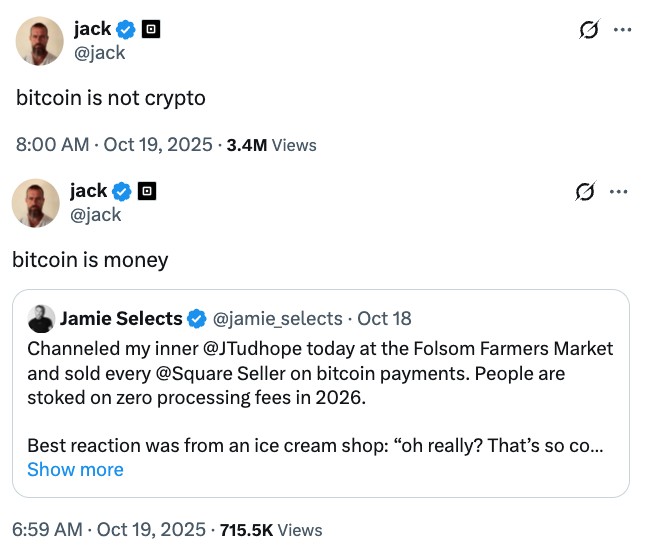
The Bitcoin Dichotomy: Money or Crypto?
The recent assertion by Jack Dorsey, “Bitcoin is not crypto,” reignited a long-standing discussion within the digital asset community. While the lines between Bitcoin and the broader cryptocurrency landscape have often blurred, Dorsey’s statement highlights key distinctions that are crucial to understanding Bitcoin‘s unique position. This article delves into the core arguments, examining Bitcoin’s fundamental design, governance, and market perception to illuminate why it might indeed belong in a category of its own.
Design and Monetary Policy: Fixed vs. Flexible
One of the most significant differences lies in the underlying design and monetary policy. Bitcoin operates on a fixed supply schedule, capped at 21 million coins, with issuance decreasing over time through the halving events. This pre-programmed scarcity is a cornerstone of Bitcoin‘s value proposition, offering a degree of predictability that is absent in many other cryptocurrencies. In contrast, many altcoins, including Ethereum, employ flexible monetary policies, allowing for adjustments to supply based on network activity and demand.
Governance and Consensus: Slow and Steady vs. Rapid Evolution
Bitcoin‘s governance model prioritizes stability and security, favoring slow, deliberate changes. Modifications to the Bitcoin protocol require broad consensus among developers, miners, and node operators, making significant upgrades rare and cautiously implemented. This contrasts sharply with the iterative development cycles of many smart contract platforms, which often prioritize the integration of new features and functionalities. The Taproot upgrade serves as an example of this deliberative process. Conversely, platforms like Ethereum undergo more rapid development, incorporating improvements through the Ethereum Improvement Proposal (EIP) process.
Security and the Mining Model: Proof-of-Work vs. Proof-of-Stake
Bitcoin‘s security relies on the Proof-of-Work (PoW) consensus mechanism, where miners expend computational power to secure the network. This approach prioritizes decentralization and resistance to censorship, although it can be energy-intensive. Many alternative cryptocurrencies utilize Proof-of-Stake (PoS) mechanisms, where validators stake their tokens to secure the network. While PoS can offer higher throughput and energy efficiency, it also introduces different trade-offs in terms of security and decentralization.
Market Perception and Institutional Adoption: Separate Buckets
Perhaps the most compelling evidence for Bitcoin‘s unique status lies in its market perception and institutional adoption. The approval of spot Bitcoin ETFs in the US marked a watershed moment, integrating Bitcoin into the traditional financial system. This development has provided mainstream investors with a familiar vehicle for Bitcoin exposure, separate from the complexities of the broader crypto market. Furthermore, regulatory bodies often classify Bitcoin differently, viewing it more as a commodity than a security, further solidifying its distinct identity.

Conclusion: Bitcoin‘s Singular Journey
The debate over whether Bitcoin is “crypto” or something else is likely to continue. However, the fundamental differences in its design, governance, and market positioning suggest a compelling case for its unique classification. As Bitcoin matures and gains wider adoption, its divergence from the rest of the crypto market may only become more pronounced. Its focus on monetary credibility, security, and long-term value preservation continues to set it apart in the dynamic and often volatile world of digital assets.


